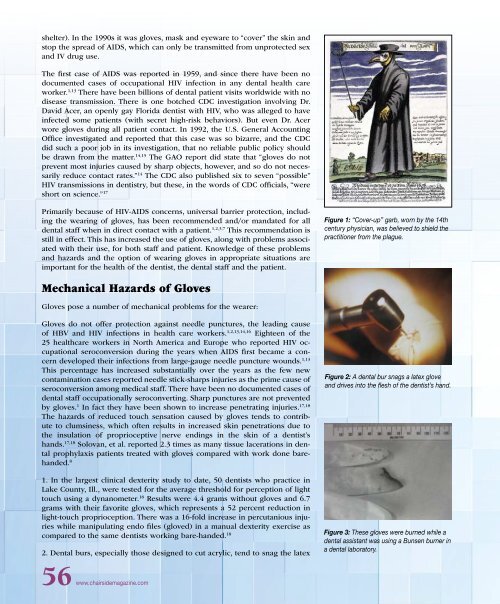PDF Version - Glidewell Dental Labs
PDF Version - Glidewell Dental Labs
PDF Version - Glidewell Dental Labs
You also want an ePaper? Increase the reach of your titles
YUMPU automatically turns print PDFs into web optimized ePapers that Google loves.
shelter). In the 1990s it was gloves, mask and eyeware to “cover” the skin and<br />
stop the spread of AIDS, which can only be transmitted from unprotected sex<br />
and IV drug use.<br />
The first case of AIDS was reported in 1959, and since there have been no<br />
documented cases of occupational HIV infection in any dental health care<br />
worker. 1,13 There have been billions of dental patient visits worldwide with no<br />
disease transmission. There is one botched CDC investigation involving Dr.<br />
David Acer, an openly gay Florida dentist with HIV, who was alleged to have<br />
infected some patients (with secret high-risk behaviors). But even Dr. Acer<br />
wore gloves during all patient contact. In 1992, the U.S. General Accounting<br />
Office investigated and reported that this case was so bizarre, and the CDC<br />
did such a poor job in its investigation, that no reliable public policy should<br />
be drawn from the matter. 14,15 The GAO report did state that “gloves do not<br />
prevent most injuries caused by sharp objects, however, and so do not necessarily<br />
reduce contact rates.” 14 The CDC also published six to seven “possible”<br />
HIV transmissions in dentistry, but these, in the words of CDC officials, “were<br />
short on science.” 17<br />
Primarily because of HIV-AIDS concerns, universal barrier protection, including<br />
the wearing of gloves, has been recommended and/or mandated for all<br />
dental staff when in direct contact with a patient. 1,2,3,7 This recommendation is<br />
still in effect. This has increased the use of gloves, along with problems associated<br />
with their use, for both staff and patient. Knowledge of these problems<br />
and hazards and the option of wearing gloves in appropriate situations are<br />
important for the health of the dentist, the dental staff and the patient.<br />
Figure 1: “Cover-up” garb, worn by the 14th<br />
century physician, was believed to shield the<br />
practitioner from the plague.<br />
Mechanical Hazards of Gloves<br />
Gloves pose a number of mechanical problems for the wearer:<br />
Gloves do not offer protection against needle punctures, the leading cause<br />
of HBV and HIV infections in health care workers. 1,2,13,14,16 Eighteen of the<br />
25 healthcare workers in North America and Europe who reported HIV occupational<br />
seroconversion during the years when AIDS first became a concern<br />
developed their infections from large-gauge needle puncture wounds. 1,13<br />
This percentage has increased substantially over the years as the few new<br />
contamination cases reported needle stick-sharps injuries as the prime cause of<br />
seroconversion among medical staff. There have been no documented cases of<br />
dental staff occupationally seroconverting. Sharp punctures are not prevented<br />
by gloves. 1 In fact they have been shown to increase penetrating injuries. 17,18<br />
The hazards of reduced touch sensation caused by gloves tends to contribute<br />
to clumsiness, which often results in increased skin penetrations due to<br />
the insulation of proprioceptive nerve endings in the skin of a dentist’s<br />
hands. 17,18 Solovan, et al. reported 2.3 times as many tissue lacerations in dental<br />
prophylaxis patients treated with gloves compared with work done barehanded.<br />
8<br />
1. In the largest clinical dexterity study to date, 50 dentists who practice in<br />
Lake County, Ill., were tested for the average threshold for perception of light<br />
touch using a dynanometer. 18 Results were 4.4 grams without gloves and 6.7<br />
grams with their favorite gloves, which represents a 52 percent reduction in<br />
light-touch proprioception. There was a 16-fold increase in percutanious injuries<br />
while manipulating endo files (gloved) in a manual dexterity exercise as<br />
compared to the same dentists working bare-handed. 18<br />
2. <strong>Dental</strong> burs, especially those designed to cut acrylic, tend to snag the latex<br />
Figure 2: A dental bur snags a latex glove<br />
and drives into the flesh of the dentist’s hand.<br />
Figure 3: These gloves were burned while a<br />
dental assistant was using a Bunsen burner in<br />
a dental laboratory.<br />
56 www.chairsidemagazine.com

















